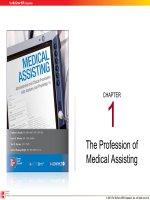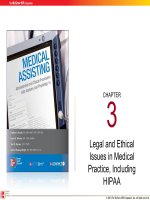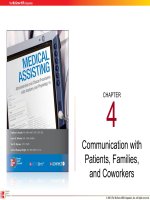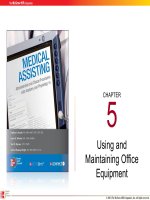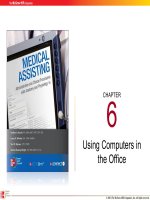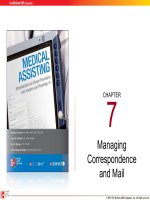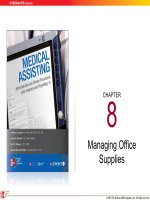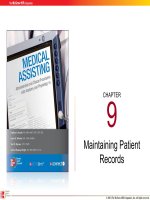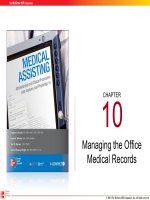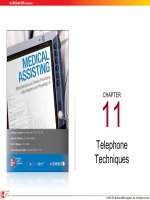Lecture Medical assisting: Administrative and clinical procedures with anatomy and physiology (4e) – Chapter 19
Bạn đang xem bản rút gọn của tài liệu. Xem và tải ngay bản đầy đủ của tài liệu tại đây (1.34 MB, 64 trang )
CHAPTER
19
Organization of the
Body
© 2011 T he McGraw -Hill Com panie s, Inc. A ll rights reserv ed.
19-2
Learning Outcomes
19.1 Describe body organization from simple to
more complex levels.
19.2 List the body organ systems, their general
functions, and the major organs contained in
each.
19.3 Define the anatomical position and explain its
importance.
19.4 Use medical and anatomical terminology
correctly.
© 2011 T he McGraw -Hill Com panie s, Inc. A ll rights reserv ed.
19-3
Learning Outcomes (cont.)
19.5 Name the body cavities and the organs
contained in each.
19.6 Explain the abdominal regions and
quadrants.
19.7 Explain why a basic understanding of
chemistry is important in studying the body.
19.8 Describe important molecules and
compounds of the human body.
© 2011 T he McGraw -Hill Com panie s, Inc. A ll rights reserv ed.
19-4
Learning Outcomes (cont.)
19.9 Label the parts of a cell and list their
functions.
19.10 List and describe the ways substances
move across a cell membrane.
19.11 Describe the stages of cell division.
19.12 Explain how mutations occur and what
effects they may produce.
© 2011 T he McGraw -Hill Com panie s, Inc. A ll rights reserv ed.
19-5
Learning Outcomes (cont.)
19.13 Describe the uses of the genetic techniques,
DNA fingerprinting, and the polymerase
chain reaction.
19.14 Describe the different patterns of
inheritance.
19.15 Describe the locations and characteristics of
the four main tissue types.
19.16 Describe the signs and symptoms of various
genetic conditions.
© 2011 T he McGraw -Hill Com panie s, Inc. A ll rights reserv ed.
19-6
Introduction
•
Human body is
complex in its
structure and
function
•
The body is
organized from the
chemical level all
the way up to the
organ system level
You will also learn important terminology used
in the clinical setting to describe body positions
and parts.
© 2011 T he McGraw -Hill Com panie s, Inc. A ll rights reserv ed.
19-7
Study of the Body
•
Anatomy
– Study of body structure
– Normal position of body structures
•
Physiology
– Study of function
•
Anatomy of the body allows it to
function
© 2011 T he McGraw -Hill Com panie s, Inc. A ll rights reserv ed.
19-8
Study of the Body (cont.)
•
Homeostasis
– Relative consistency of the
body’s internal environment
– Body conditions must remain
stable
© 2011 T he McGraw -Hill Com panie s, Inc. A ll rights reserv ed.
19-9
Apply Your Knowledge
True or False:
T
___
ANSWER:
Anatomy is the study of structure.
F Physiology is the study of function and
___
structure.
Physiology is the study of function.
T Homeostasis is the relative consistency of the
___
body’s internal environment.
© 2011 T he McGraw -Hill Com panie s, Inc. A ll rights reserv ed.
19-10
Organization of the Body
Organism (human)
Levels of Organization
Organ Systems
Organs
Tissues
Cells
Organelles
Molecule
Atom
© 2011 T he McGraw -Hill Com panie s, Inc. A ll rights reserv ed.
19-11
Body Organs and Systems
•
Organ
– Structure formed by organization of two
or more different tissue types that work
together to carry out specific functions
•
Organ system
– Organs join together to carry out vital
functions
© 2011 T he McGraw -Hill Com panie s, Inc. A ll rights reserv ed.
19-12
Body Organs and Systems (cont.)
•
For example
– The respiratory system
consists of the following
organs:
•
•
•
•
•
•
Nose
Nasal cavity
Pharynx
Larynx
Bronchi
Lungs
© 2011 T he McGraw -Hill Com panie s, Inc. A ll rights reserv ed.
19-13
Apply Your Knowledge
1. Match the following:
ANSWER:
C Atoms
___
A.
The smallest living units in the body
___
B Matter
B.
Anything that takes up space and
has weight
G Molecules
___
C.
Simplest unit of matter
E Organelles
___
D.
Same type of cells organized
together
A Cells
___
E.
Molecules joined together
D Tissues
___
F.
Combination of two or more tissue
types
F Organs
___
G.
Atoms that bond together
© 2011 T he McGraw -Hill Com panie s, Inc. A ll rights reserv ed.
19-14
Apply Your Knowledge
2. What is the difference between organs and organ
systems?
ANSWER: Organs are made of tissues working
together to carry out a specific function and an organ
system is formed when organs work together to carry
out vital functions.
3. List two major components of the cardiovascular
system.
The heart and blood vessels
Right!
© 2011 T he McGraw -Hill Com panie s, Inc. A ll rights reserv ed.
19-15
Understanding Medical Terminology
• Word root – contains base meaning
• Suffix
– At end of term
– Alters the meaning of the word root
• Prefix
– At the beginning of the term
– Alters the meaning of the term
© 2011 T he McGraw -Hill Com panie s, Inc. A ll rights reserv ed.
19-16
Understanding Medical Terminology (cont.)
• Combining vowel
– Often an “o”
– Added between word root and suffix when
suffix begins with a consonant to ease
pronunciation
– Does not alter meaning
© 2011 T he McGraw -Hill Com panie s, Inc. A ll rights reserv ed.
19-17
Anatomical Terminology
•
Terms used to describe the location of body parts and
various body regions
•
Anatomical position – body is standing upright, facing
forward, with the arms at the sides and palms of hands
facing forward
•
Used to identify the position of body structures
compared to other body surfaces
© 2011 T he McGraw -Hill Com panie s, Inc. A ll rights reserv ed.
19-22
Apply Your Knowledge
1. Combine terms to answer definition.
CARDIOLOGIST
heart specialist
TACHYCARDIA
rapid heart beat
CARDIOLOGY
specialty of the heart
TACHY
ANSWER:
CARDI
IA
LOGIST
LOGY
O
© 2011 T he McGraw -Hill Com panie s, Inc. A ll rights reserv ed.
19-23
Apply Your Knowledge
2. What is the anatomical position?
ANSWER: Anatomical position is the body
standing upright, facing forward, with the arms
at the sides and palms of hands facing forward.
Good
Answer!
© 2011 T he McGraw -Hill Com panie s, Inc. A ll rights reserv ed.
19-24
Body Cavities and Abdominal Regions
•
Dorsal cavity
– Cranial – brain
– Spinal – spinal cord
© 2011 T he McGraw -Hill Com panie s, Inc. A ll rights reserv ed.
19-25
Body Cavities and Abdominal Regions
(cont.)
• Ventral cavity
– Thoracic – lungs, heart,
esophagus, and trachea
– Diaphragm – muscle
separating these two sections
– Abdominopelvic
• Abdominal cavity – organs of
digestion
• Pelvic cavity – bladder and
internal reproductive organs
© 2011 T he McGraw -Hill Com panie s, Inc. A ll rights reserv ed.
19-26
Apply Your Knowledge
What are the two largest body cavities?
ANSWER: Dorsal and ventral cavities
YES!
© 2011 T he McGraw -Hill Com panie s, Inc. A ll rights reserv ed.
19-27
Chemistry of Life
•
Chemistry
– The study of what
matter is composed of
and how matter
changes
•
Body structures and
functions result from
chemical changes that
occur within body cells or
fluids
© 2011 T he McGraw -Hill Com panie s, Inc. A ll rights reserv ed.
19-28
Chemistry of Life (cont.)
•
Molecules
– Two or more atoms
chemically combine
– Basic unit of
compounds
•
Compounds
– Two or more atoms of
more than one
element combine
– Water is an example of
a compound
•
2 hydrogen atoms and
1 oxygen atom
•
Critical to both chemical
and physical processes
in human physiology
•
About 2/3 of your body
weight.
© 2011 T he McGraw -Hill Com panie s, Inc. A ll rights reserv ed.
19-29
Chemistry of Life (cont.)
• Metabolism – overall chemical functioning of the body
– Anabolism
• Small molecules combine to form larger ones
– Catabolism
• Larger molecules are broken down into smaller ones
© 2011 T he McGraw -Hill Com panie s, Inc. A ll rights reserv ed.
